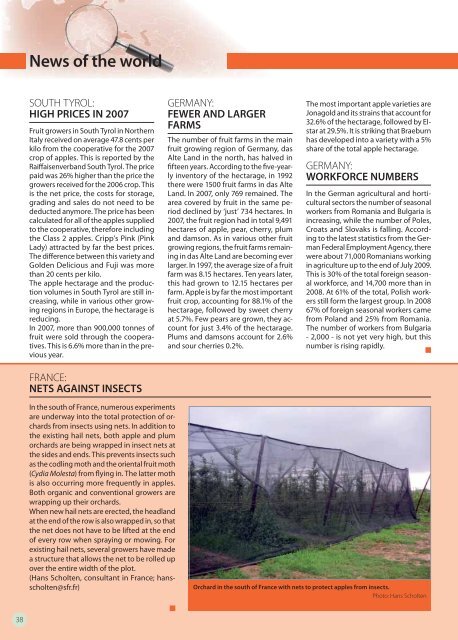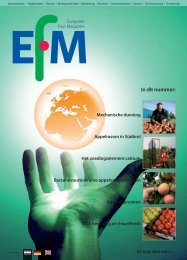In this edition: - The European Fruit Magazine
In this edition: - The European Fruit Magazine
In this edition: - The European Fruit Magazine
Create successful ePaper yourself
Turn your PDF publications into a flip-book with our unique Google optimized e-Paper software.
38<br />
News of the world<br />
SOUTH TYROL:<br />
HIGH PRICES IN 2007<br />
<strong>Fruit</strong> growers in South Tyrol in Northern<br />
Italy received on average 47.8 cents per<br />
kilo from the cooperative for the 2007<br />
crop of apples. This is reported by the<br />
Raiff aisenverband South Tyrol. <strong>The</strong> price<br />
paid was 26% higher than the price the<br />
growers received for the 2006 crop. This<br />
is the net price, the costs for storage,<br />
grading and sales do not need to be<br />
deducted anymore. <strong>The</strong> price has been<br />
calculated for all of the apples supplied<br />
to the cooperative, therefore including<br />
the Class 2 apples. Cripp’s Pink (Pink<br />
Lady) attracted by far the best prices.<br />
<strong>The</strong> diff erence between <strong>this</strong> variety and<br />
Golden Delicious and Fuji was more<br />
than 20 cents per kilo.<br />
<strong>The</strong> apple hectarage and the production<br />
volumes in South Tyrol are still increasing,<br />
while in various other growing<br />
regions in Europe, the hectarage is<br />
reducing.<br />
<strong>In</strong> 2007, more than 900,000 tonnes of<br />
fruit were sold through the cooperatives.<br />
This is 6.6% more than in the previous<br />
year.<br />
FRANCE:<br />
NETS AGAINST INSECTS<br />
GERMANY:<br />
FEWER AND LARGER<br />
FARMS<br />
<strong>The</strong> number of fruit farms in the main<br />
fruit growing region of Germany, das<br />
Alte Land in the north, has halved in<br />
fi fteen years. According to the fi ve-yearly<br />
inventory of the hectarage, in 1992<br />
there were 1500 fruit farms in das Alte<br />
Land. <strong>In</strong> 2007, only 769 remained. <strong>The</strong><br />
area covered by fruit in the same period<br />
declined by ‘just’ 734 hectares. <strong>In</strong><br />
2007, the fruit region had in total 9,491<br />
hectares of apple, pear, cherry, plum<br />
and damson. As in various other fruit<br />
growing regions, the fruit farms remaining<br />
in das Alte Land are becoming ever<br />
larger. <strong>In</strong> 1997, the average size of a fruit<br />
farm was 8.15 hectares. Ten years later,<br />
<strong>this</strong> had grown to 12.15 hectares per<br />
farm. Apple is by far the most important<br />
fruit crop, accounting for 88.1% of the<br />
hectarage, followed by sweet cherry<br />
at 5.7%. Few pears are grown, they account<br />
for just 3.4% of the hectarage.<br />
Plums and damsons account for 2.6%<br />
and sour cherries 0.2%.<br />
<strong>The</strong> most important apple varieties are<br />
Jonagold and its strains that account for<br />
32.6% of the hectarage, followed by Elstar<br />
at 29.5%. It is striking that Braeburn<br />
has developed into a variety with a 5%<br />
share of the total apple hectarage.<br />
GERMANY:<br />
WORKFORCE NUMBERS<br />
<strong>In</strong> the German agricultural and horticultural<br />
sectors the number of seasonal<br />
workers from Romania and Bulgaria is<br />
increasing, while the number of Poles,<br />
Croats and Slovaks is falling. According<br />
to the latest statistics from the German<br />
Federal Employment Agency, there<br />
were about 71,000 Romanians working<br />
in agriculture up to the end of July 2009.<br />
This is 30% of the total foreign seasonal<br />
workforce, and 14,700 more than in<br />
2008. At 61% of the total, Polish workers<br />
still form the largest group. <strong>In</strong> 2008<br />
67% of foreign seasonal workers came<br />
from Poland and 25% from Romania.<br />
<strong>The</strong> number of workers from Bulgaria<br />
- 2,000 - is not yet very high, but <strong>this</strong><br />
number is rising rapidly.<br />
<strong>In</strong> the south of France, numerous experiments<br />
are underway into the total protection of orchards<br />
from insects using nets. <strong>In</strong> addition to<br />
the existing hail nets, both apple and plum<br />
orchards are being wrapped in insect nets at<br />
the sides and ends. This prevents insects such<br />
as the codling moth and the oriental fruit moth<br />
(Cydia Molesta) from fl ying in. <strong>The</strong> latter moth<br />
is also occurring more frequently in apples.<br />
Both organic and conventional growers are<br />
wrapping up their orchards.<br />
When new hail nets are erected, the headland<br />
at the end of the row is also wrapped in, so that<br />
the net does not have to be lifted at the end<br />
of every row when spraying or mowing. For<br />
existing hail nets, several growers have made<br />
a structure that allows the net to be rolled up<br />
over the entire width of the plot.<br />
(Hans Scholten, consultant in France; hansscholten@sfr.fr)<br />
Orchard in the south of France with nets to protect apples from insects.<br />
Photo: Hans Scholten



